This sorghum sourdough bread is everything I look for in a wholesome artisan loaf — gluten-free, lectin-free, and made with just a handful of clean ingredients — no gums, no fillers, no fuss.
The crumb is sturdy and slightly dense, which means each slice toasts like a dream and stands up to butter, jam, or whatever toppings you love. Fermented with a wild, gluten-free starter, it’s both nourishing and gut-friendly — and approachable even if you’re brand-new to sourdough baking.
Introduction: One-Flour Bread
This Sorghum Sourdough Bread is part of my One-Flour Bread Series, where I showcase individual recipes using each of the three main flours in my gluten-free sourdough method: millet, sorghum, and teff.
For all my gluten-free sourdough loaves, I use my active starter, Rosie, which I regularly feed with a mix of millet, sorghum, and teff flours. When developing recipes, I work with a preferment (or levain) — a blend of active starter, water, and the flour featured in the recipe.
In this case, the preferment is made with 10g of starter, 30g of water, and 35g of sorghum flour. It takes about 6–7 hours to reach peak activity, and it should be used within 10 hours for best results. You can speed up fermentation by placing it in a gently warmed (but turned-off) oven or on a heating pad, reducing the proofing time to as little as 3 hours.
A ready-to-use preferment will double in size, form a dome, and develop cracks on the surface — signs that it’s airy and active.
If you’re new to gluten-free sourdough, I highly recommend starting with my Beginner’s Guide to Baking Gluten-Free Sourdough Bread. You can also learn how to build a strong, versatile starter like Rosie in my Gluten-Free Sourdough Starter Guide.
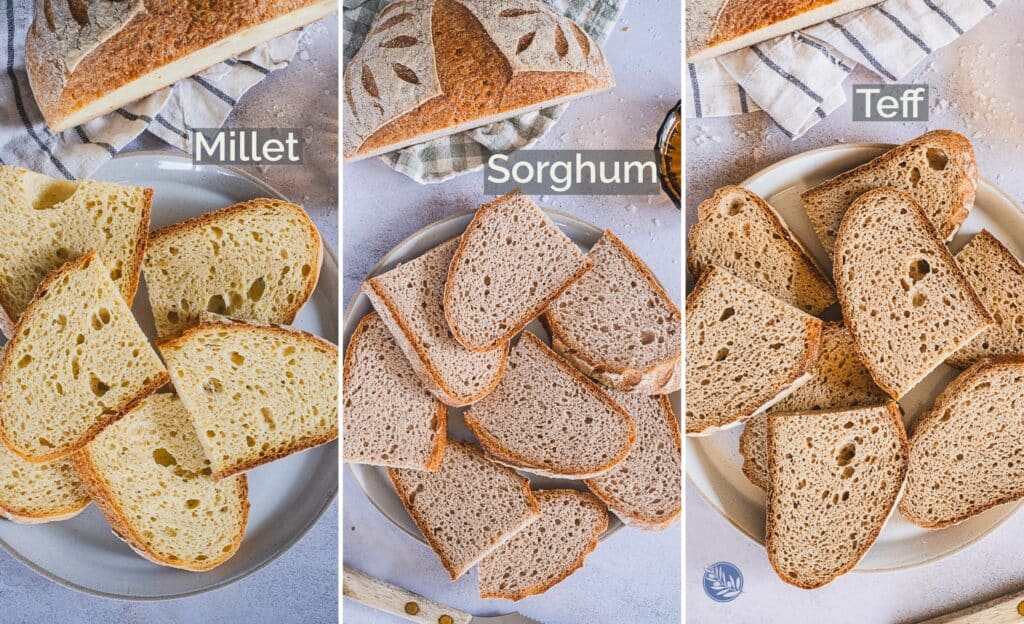
Sorghum — an Ancient Grain with Modern Appeal
Sorghum is one of humanity’s original cereal crops — a drought-resilient grass first cultivated in Africa thousands of years ago and now grown on every inhabited continent. Before wheat gained global dominance, this small, pearl-like grain fed countless communities from the savannas of Sudan to the plains of India. Today it is enjoying a quiet renaissance as people rediscover its climate resilience, gentle flavor, and impressive nutrition profile.
Nutritionally, sorghum punches above its weight. It is naturally gluten-free and lectin-free and delivers a solid dose of protein, iron, magnesium, phosphorus, and gut-loving fiber. Early research even suggests that sorghum may boost satiety by raising GLP-1 levels — the same hormone pathway popular weight-loss drugs act on — offering metabolic support without pharmaceutical side effects. And if you follow a low-FODMAP approach, sorghum flour fits comfortably into the plan at standard baking quantities.
As a flour, sorghum (also called “jowar”) feels familiar — soft, ivory to buff in color, and finely milled. Its flavor is neutral-to-nutty, reminiscent of whole-wheat or graham flour, so it readily picks up the taste of whatever you pair it with.
In artisan-style bread, sorghum creates a tighter, slightly denser crumb than millet or teff — one of the reasons I prefer to pair sorghum with other flours in my sourdough baking. For a lighter, softer texture, try our enriched Sorghum Sandwich Bread, made with commercial yeast.
However, when you want a simple bake with just sorghum flour, this bread is perfect for slices that toast up beautifully and hold their structure under layers of butter, nut butter, or a runny fried egg.
This loaf is the second recipe in my one-flour sourdough series, spotlighting the three gut-friendly grains that are naturally gluten- and lectin-free: millet, sorghum, and teff. If you’d like to explore more textures and flavors, try:
- My multigrain open-baked sourdough with millet, sorghum, and teff
- My fluffy hemp-enriched sourdough for extra protein and fiber
- My millet-and-sorghum loaf — a light, everyday white-bread alternative
Let’s bake!
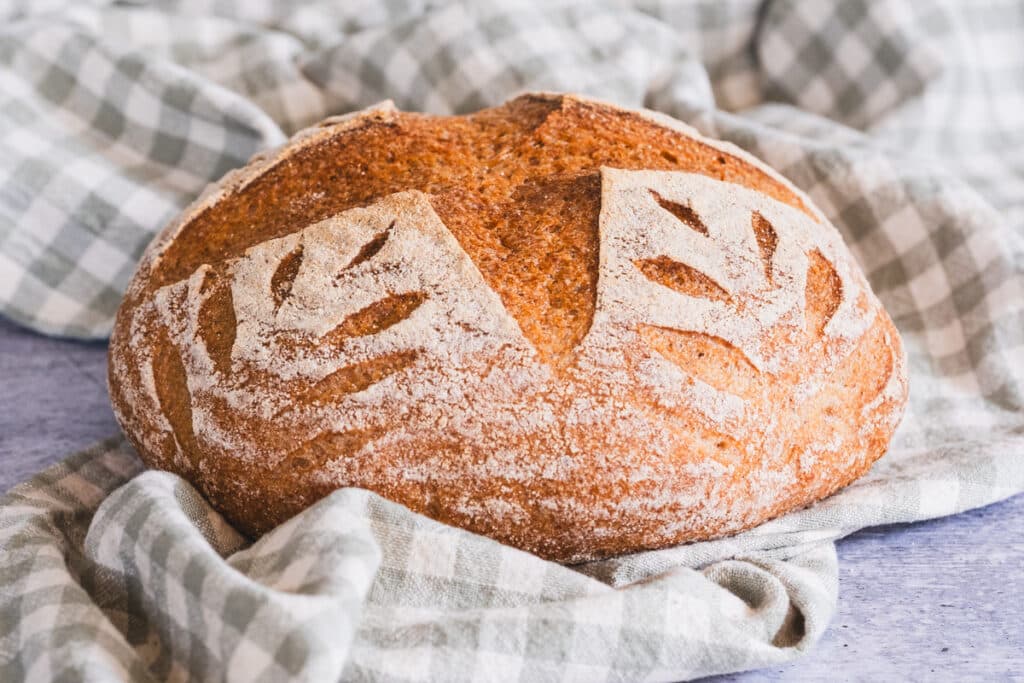
Basic Tools
- Digital kitchen scale (a must!)
- 2 mixing bowls (glass or plastic)
- Silicone spatula or wooden spoon
- Flexible dough scraper (plastic is good)
- Proofing basket (Banneton) or a small bowl lined with a clean cloth
- Dutch oven or heavy cast iron pot with a lid
- Heavy-duty parchment paper
- Razor blade or scoring knife
Ingredients
Just six simple ingredients — plus water — are all you need to make this artisan sourdough loaf with sorghum flour. You’ll find the full ingredient list with exact measurements in the step-by-step guide below and in the printable recipe card at the end of the post.
For the best results, use fresh, organic sorghum flour and mineral-rich bottled water. I don’t recommend reverse osmosis water unless it has been properly remineralized, as the minerals play an important role in fermentation.
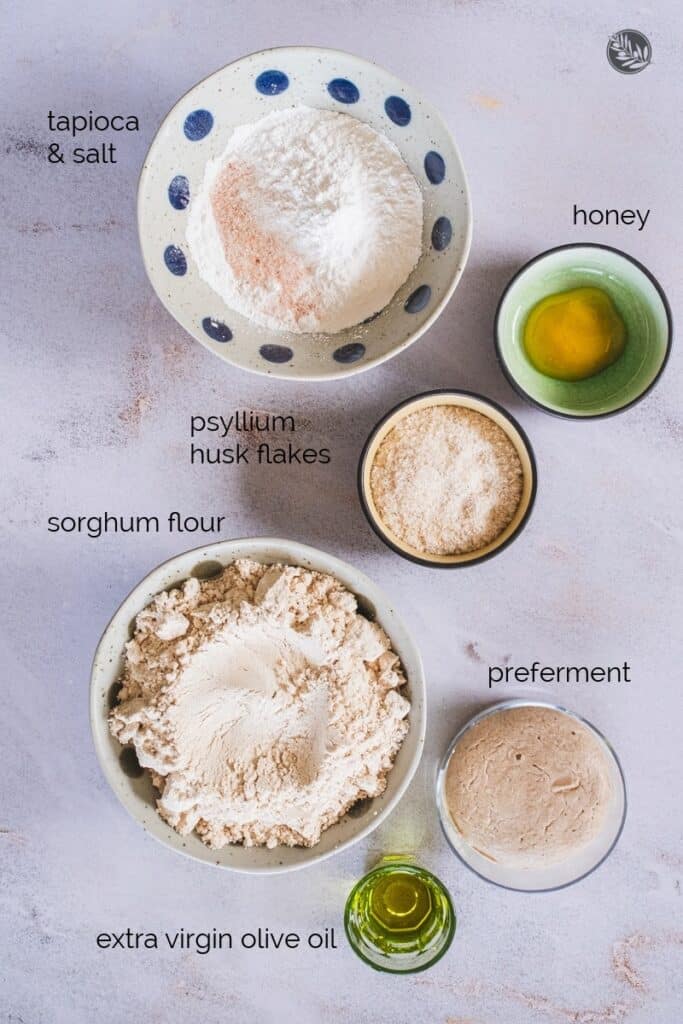
How to Make Sorghum Sourdough Bread
Step 1: Prepare the Preferment (The Night Before Baking, or 6-8 hours before)
Ingredients:
- 10g active sourdough starter
- 30g filtered water
- 35g sorghum flour
Instructions:
Do this in the evening, or 6-7 hours before mixing the dough. In a small clean jar, mix all ingredients thoroughly until no dry flour remains. I make the preferment the same time I feed my starter.
Cover lightly and leave to ferment at room temperature (21–23°C / 70–74°F) overnight. If you want to make the preferment in the morning, it will take about 6-7 hours for it to reach peak activity. To speed it up (to about 3h), you can use a heating pad or a gently heated oven (make sure the heat is OFF).
When at peak, the preferment should be bubbly, almost doubled, cracked on top, and have a light, pleasant aroma. For best results, please use it within 10h.
Step 2: Mix the Wet Ingredients
Ingredients:
- 17g whole psyllium husk flakes
- 420g filtered water, divided (400g+20g)
- 10g raw honey (helps fermentation; if vegan, use maple syrup)
- 10g extra virgin olive oil
- All of the preferment
Instructions:
In a medium bowl, mix psyllium flakes, honey, and olive oil with 400g of water. Stir until the honey dissolves. Let sit for 3–5 minutes to allow a thick gel to form.
Add all of the preferment. Use the remaining 20g of water to rinse the preferment jar, making sure every bit of the preferment goes into the dough. Mix well until everything is fully incorporated and the mixture is smooth and uniform.
Step 3: Mix the Dry Ingredients
Ingredients:
- 230g sorghum flour
- 70g tapioca flour
- 6g fine sea salt (non-iodized)
Instructions:
In a large mixing bowl, whisk the flours and salt together thoroughly.
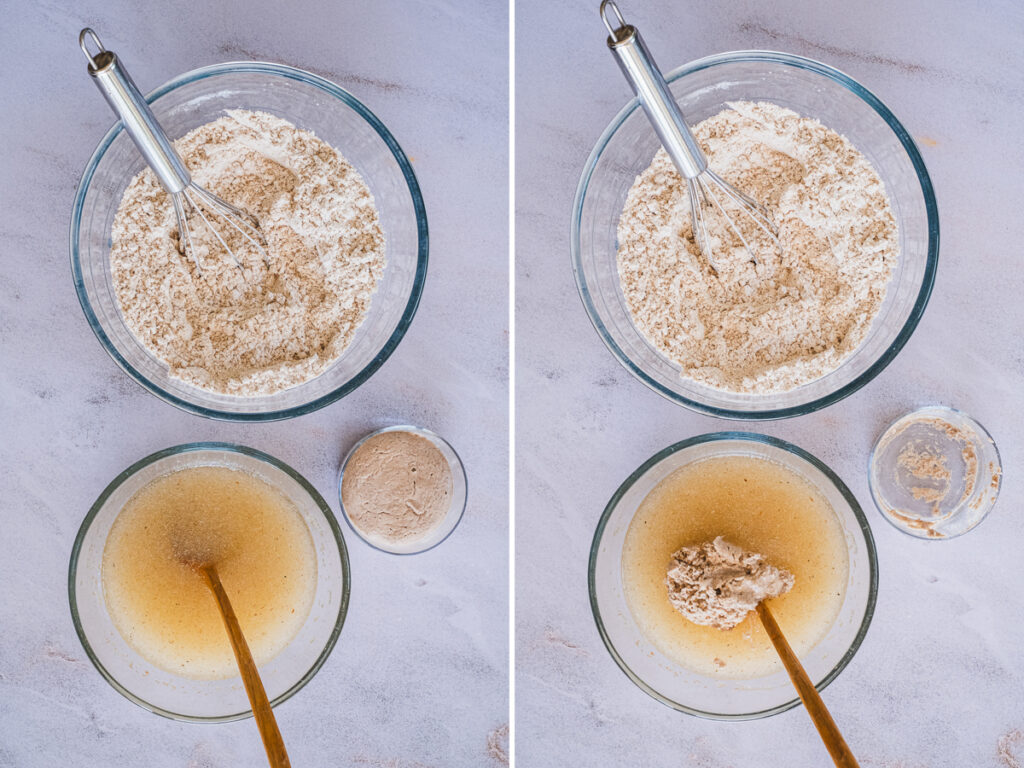
Step 4: Combine Wet and Dry Mixtures
Add the wet gel mixture to the dry flour bowl.
Start mixing with a spatula, then use clean hands to thoroughly mix the dough, until an homogeneous dough forms (about 1-2 minutes). Scrape down the sides with the dough scraper and fold the dough toward the center, rotating the bowl. Repeat the fold about 20 times.
The dough will be thick, soft, and slightly sticky.
Cover the bowl with a lid and set in a draft-free, warm spot (room temperature is fine if not too cold).
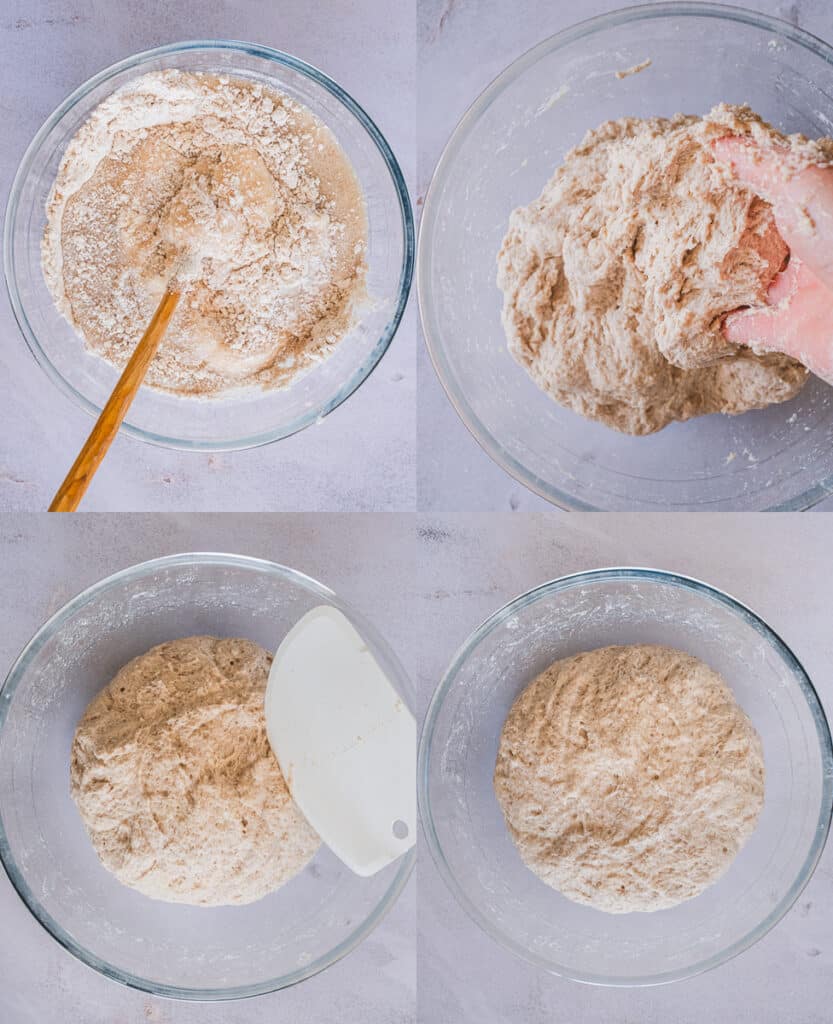
Step 5: Bulk Fermentation (First Rise)
Let the dough ferment at room temperature for 1 to 2 hours, depending on the ambient conditions. This is something you’ll get a feel for with practice. As a general rule: in summer, 1 hour is often enough; in winter, when the house is cooler, it can take up to 2 hours.
I made this loaf in the summer and bulk fermented it for 1 hour at around 72°F (22°C).
Signs it’s ready: slight puffing, a smoother and lighter texture. If you are using a glass bowl (which I recommend), you will notice holes on the bottom and on the sides of the dough.
Step 6: Shaping the Loaf
Lightly flour a clean surface.
Gently invert the dough onto the surface. Gently grab the side further from you, and fold it over to the center of the dough, then repeat with one more fold, toward you. You are basically tightly rolling the dough towards you.
Now the seam-side should be on the bottom. Use your hands to create a slight tension between the dough and the surface, by gently rotate it and round it into a smooth ball, and the seam is well sealed. Lightly dust the top of the dough with flour.
Place it seam-side up into a lightly floured proofing basket or cloth-lined bowl. Dust some flour on top and cover with a cloth and a plastic cover.
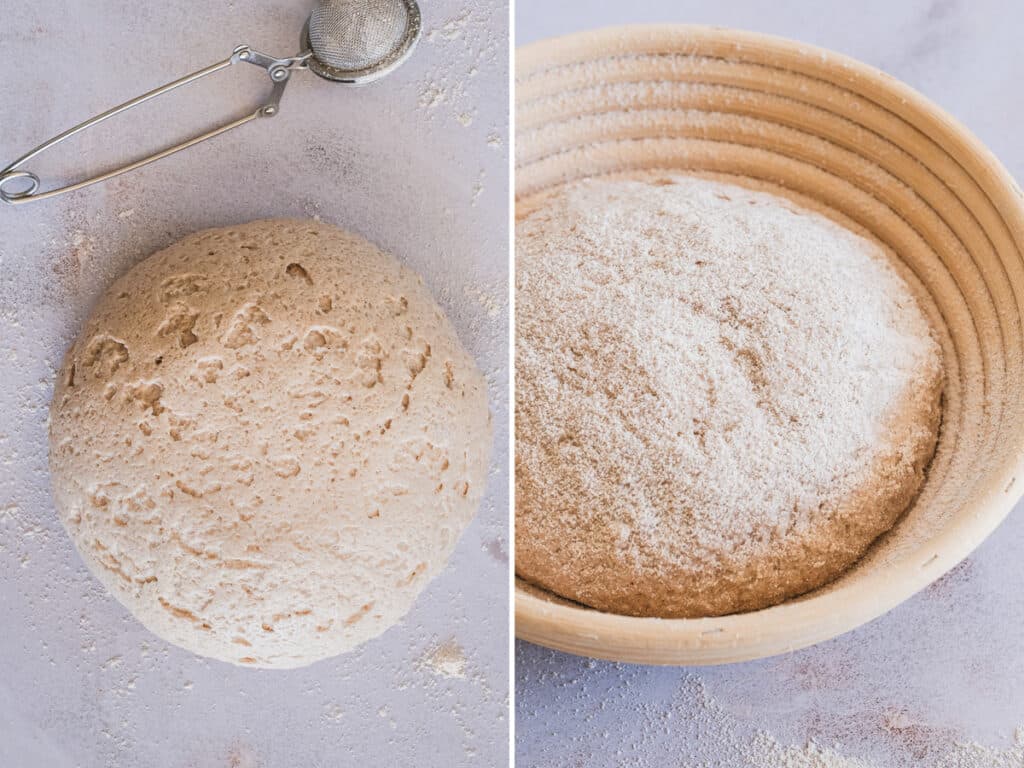
Step 7: Final Proof (Second Rise)
Proof for 1–2 hours at room temperature. At a temperature of 72F (22C), it takes about 1 hour.
In gluten-free sourdough baking, the signs that the dough is ready are not as obvious as in regular wheat baking. It’s something you will learn to recognize with practice. We are looking for a rise in dough of about 20-30%, a puffy appearance, and a slightly jiggly texture. If your dough has visibly increased in size, it is most probably overproofed.
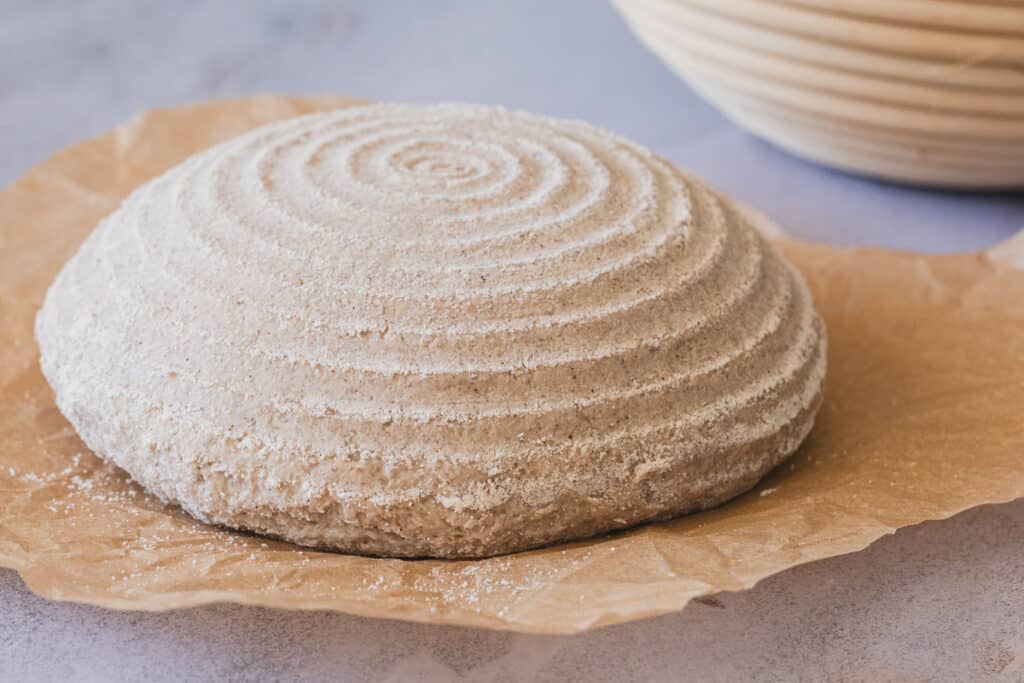
Step 8: Score and Bake
Preheat your Dutch oven with the lid in the oven at 250°C / 480°F for about 30-40 minutes before baking. This ensures the pot is thoroughly hot and will create the right oven spring.
Carefully invert the dough onto a sheet of parchment paper. Score the top with a razor blade — a simple cross, to begin with, works well. You can expand your scoring repertoire once you have mastered the method. Or use your favorite score if you are a seasoned baker.
Using oven mitts, remove the hot Dutch oven from the oven and lower the parchment paper with the dough inside. Bake covered for 40 minutes, then uncovered for another 35–40 minutes (the lid remains in the oven), until the loaf is deeply golden brown. The timing might slightly decrease if your oven runs on the hot side (if you noticed the bread had a burnt bottom and crust).
Remove the bread and place on a cooling rack. Let it cool completely — at least 5 hours, but ideally overnight — before slicing. This allows the crumb to set fully. I know is tempting, but do not slice it before 5 hours, you will end with a gummy crumb.
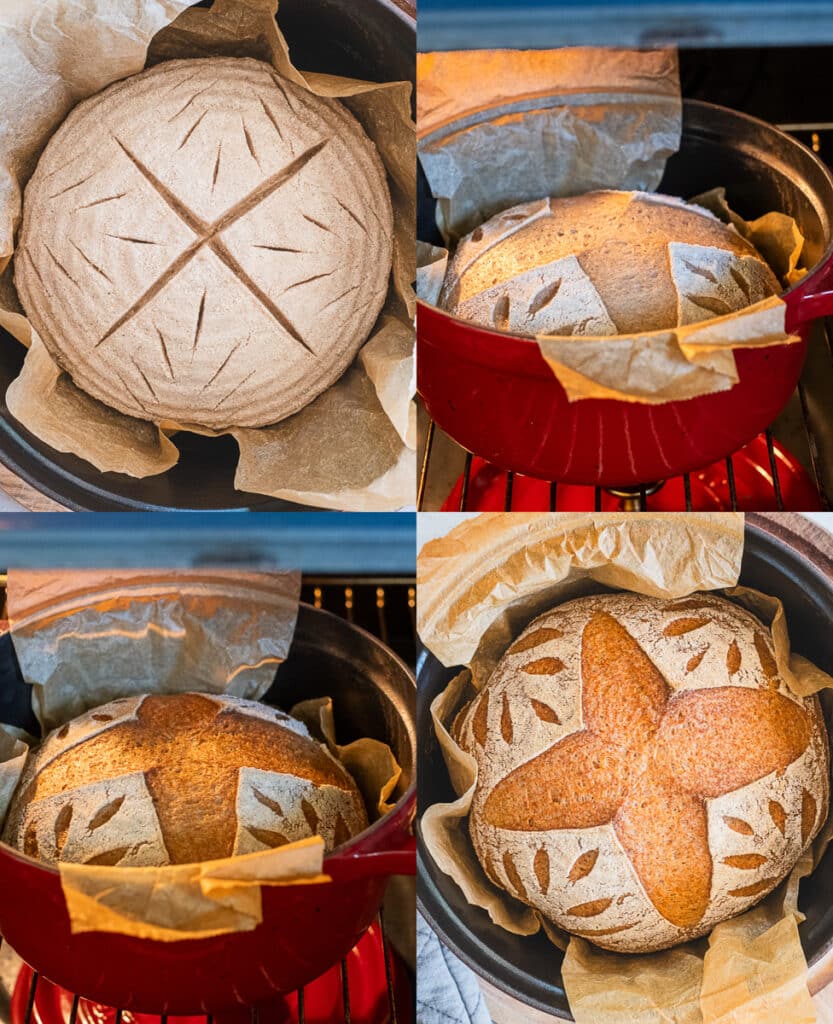
Proofing Tips:
You can accelerate fermentation (of both preferment and dough) with a warmer environment, or slow it down by using a refrigerator.
Overnight proofing:
If you make the dough later in the evening, you can proof it in the refrigerator, overnight. However, to avoid overproofing, only bulk ferment on the counter for 15 minutes, then shape and place in the proofing basket and cover. Make sure you do this as late as possible at night, and bake first thing in the morning.
Storage & Serving Tips
- Short-term: Wrap the cooled loaf in a clean cotton towel or place it in a paper bag. It keeps well at room temperature for up to 3 days.
- Long-term: Slice and freeze the loaf with parchment paper between slices. You can toast directly from frozen or let it thaw at room temperature and toast.
- Serving suggestion: This sorghum sourdough has a tighter crumb than breads made with millet or teff, so it’s best enjoyed toasted. Toasting helps bring back moisture and enhances the texture. It’s the perfect bread for a buttery morning toast.
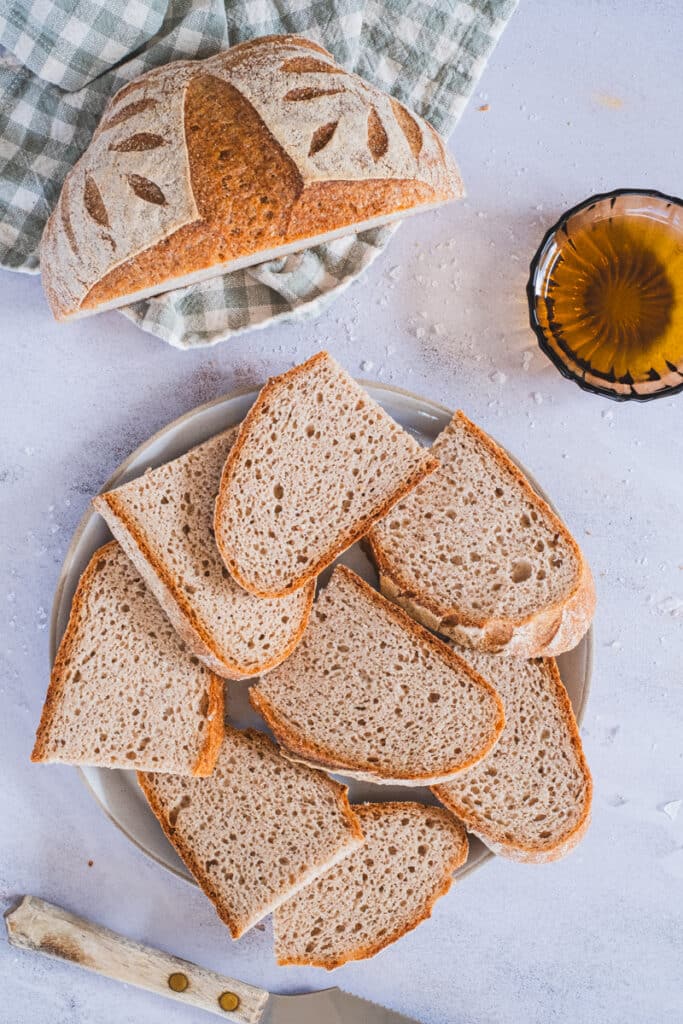
Estimated Nutritional Information
Based on 10 servings, one slice (approximately one large serving) contains 118 calories, 2.2 grams of protein, 1.8 grams of fat, 2.6 grams of fiber, and 21 grams of net carbohydrates.
For full details, see the nutritional label below the recipe card.
*This post contains affiliated links, which means I get a small commission if you choose to purchase something via one of my links, at no extra cost to you.
Print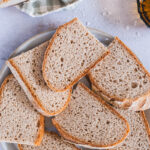
Easy Sorghum Sourdough Bread (Gluten-Free)
- Prep Time: 30 minutes
- Proofing: 2 hours
- Cook Time: 80 minutes
- Total Time: 3 hours 50 minutes
- Yield: 10 servings
Description
This sorghum sourdough is everything I look for in a wholesome loaf — gluten-free, lectin-free, and made with just a handful of clean ingredients — no gums, no fillers, no fuss. The crumb is sturdy and slightly dense, which means each slice toasts like a dream and stands up to butter, jam, or whatever toppings you love. Fermented with a wild, gluten-free starter, it’s both nourishing and gut-friendly — and approachable even if you’re brand-new to sourdough baking.
Ingredients
FOR THE PREFERMENT
- 10g active sourdough starter
- 30g filtered water
- 35g sorghum flour
FOR THE PSYLLIUM GEL
- 17g whole psyllium husk flakes
- 400g filtered water, divided (380+20)
- 10g raw honey (helps fermentation; if vegan, use sugar)
- 10g extra virgin olive oil
THE DRY INGREDIENTS
- 230g sorghum flour
- 70g tapioca flour
- 6g fine sea salt
Instructions
STEP 1: PREPARE THE PREFERMENT
- Do this in the evening, or 6-7 hours before mixing the dough. In a small clean jar, mix all ingredients thoroughly until no dry flour remains. I make the preferment the same time I feed my starter.
- Cover lightly and leave to ferment at room temperature (21–23°C / 70–74°F) overnight. If you want to make the preferment in the morning, it will take about 6-7 hours for it to reach peak activity. To speed it up (to about 3h), you can use a heating pad or a gently heated oven (make sure the heat is OFF).
- When at peak, the preferment should be bubbly, almost doubled, cracked on top, and have a light, pleasant aroma. For best results, please use it within 10h.
STEP 2: MIX THE WET INGREDIENTS
- In a medium bowl, mix psyllium flakes, honey, and olive oil with 400g of water. Stir until the honey is dissolved and all the ingredients are mixed.
- Let sit for 3–5 minutes to allow a thick gel to form.
- Add all of the preferment to the gel. Use the remaining 20g of water to rinse the preferment jar, making sure every bit of the preferment goes into the dough. Mix well until everything is fully incorporated and the mixture is smooth and uniform.
STEP 3: MIX THE DRY INGREDIENTS
- In a large mixing bowl, whisk the flours and salt together thoroughly.
STEP 4: COMBINE WET AND DRY MIXTURES
- Add the wet gel mixture to the dry flour bowl.
- Start mixing with a spatula, then use clean hands to thoroughly mix the dough, until an homogeneous dough forms (about 1-2 minutes). Scrape down the sides with the dough scraper and fold the dough toward the center, rotating the bowl. Repeat about 20 times.
- The dough will be thick, soft, and slightly sticky.
- Cover the bowl with a lid and set in a draft-free, warm spot (room temperature is fine if not too cold).
STEP 5: BULK FERMENTATION (FIRST RISE)
- Let the dough ferment at room temperature for 1 to 2 hours, depending on the ambient conditions. This is something you’ll get a feel for with practice. As a general rule: in summer, 1 hour is often enough; in winter, when the house is cooler, it can take up to 2 hours.
- I made this loaf in the summer and bulk fermented it for 1 hour at around 72°F (22°C).
- Signs it’s ready: slight puffing, a smoother and lighter texture. If you are using a glass bowl (which I recommend), you will notice holes on the bottom and on the sides of the dough.
STEP 6: SHAPING THE LOAF
- Lightly flour a clean surface.
- Gently invert the dough onto the surface. Gently grab the side further from you, and fold it over to the center of the dough, then repeat with one more fold, toward you. You are basically tightly rolling the dough towards you.
- Now the seam-side should be on the bottom. Use your hands to create a slight tension between the dough and the surface, by gently rotate it and round it into a smooth ball, and the seam is well sealed. Lightly dust the top of the dough with flour.
- Place it seam-side up into a lightly floured proofing basket or cloth-lined bowl. Dust some flour on top and cover with a cloth and a plastic cover.
STEP 7: FINAL PROOF (SECOND RISE)
- Proof for 1–2 hours at room temperature. At a temperature of 72F (22C), it takes about 1 hour.
- In gluten-free sourdough baking, the signs that the dough is ready are not as obvious as in regular wheat baking. It’s something you will learn to recognize with practice. We are looking for a rise in dough of about 20-30%, a puffy appearance, and a slightly jiggly texture. If your dough has visibly increased in size, it is most probably overproofed.
STEP 8: BAKE
- Preheat your Dutch oven with the lid in the oven at 250°C / 480°F for about 30-40 minutes before baking. This ensures the pot is thoroughly hot and will create the right oven spring.
- Carefully invert the dough onto a sheet of parchment paper. Score the top with a razor blade — a simple cross, to begin with, works well. You can expand your scoring repertoire once you have mastered the method.
- Using oven mitts, remove the hot Dutch oven from the oven and lower the parchment paper with the dough inside.
- Quickly spray the dough with water using a spray bottle, or add an ice cube to the pot before covering — this helps create steam and a beautiful crust.
- Bake covered for 40 minutes, then lower the heat to 230°C / 446°F, remove the lid, and bake uncovered for another 35–40 minutes (the lid remains in the oven), until the loaf is deeply golden brown. The timing might slightly decrease if your oven runs on the hot side (if you noticed the bread had a burnt bottom and crust).
- Remove the bread immediately and place on a cooling rack. Let it cool completely — at least 5 hours, but ideally overnight — before slicing. This allows the crumb to set fully. I know is tempting, but do not slice it before 5 hours, you will end with a gummy crumb.
- Gluten-free bread is best if lightly toasted before eating.
STORAGE and SERVING TIPS
- Short-term: Wrap the cooled loaf in a clean cotton towel or place it in a paper bag. It keeps well at room temperature for up to 3 days.
- Long-term: Slice and freeze the loaf with parchment paper between slices. You can toast directly from frozen or let it thaw at room temperature and toast.
- Serving suggestion: This sorghum sourdough has a tighter crumb than breads made with millet or teff, so it’s best enjoyed toasted. Toasting helps bring back moisture and enhances the texture. It’s the perfect bread for a buttery morning toast.
Notes
PROOFING TIPS: You can accelerate fermentation (of both preferment and dough) with a warmer environment, or slow it down by using a refrigerator.
OVERNIGHT PROOFING: If you make the dough later in the evening, you can proof it in the refrigerator, overnight. However, to avoid overproofing, only bulk ferment on the counter for 15 minutes, then shape and place in the proofing basket and cover. Make sure you do this as late as possible at night, and bake first thing in the morning.
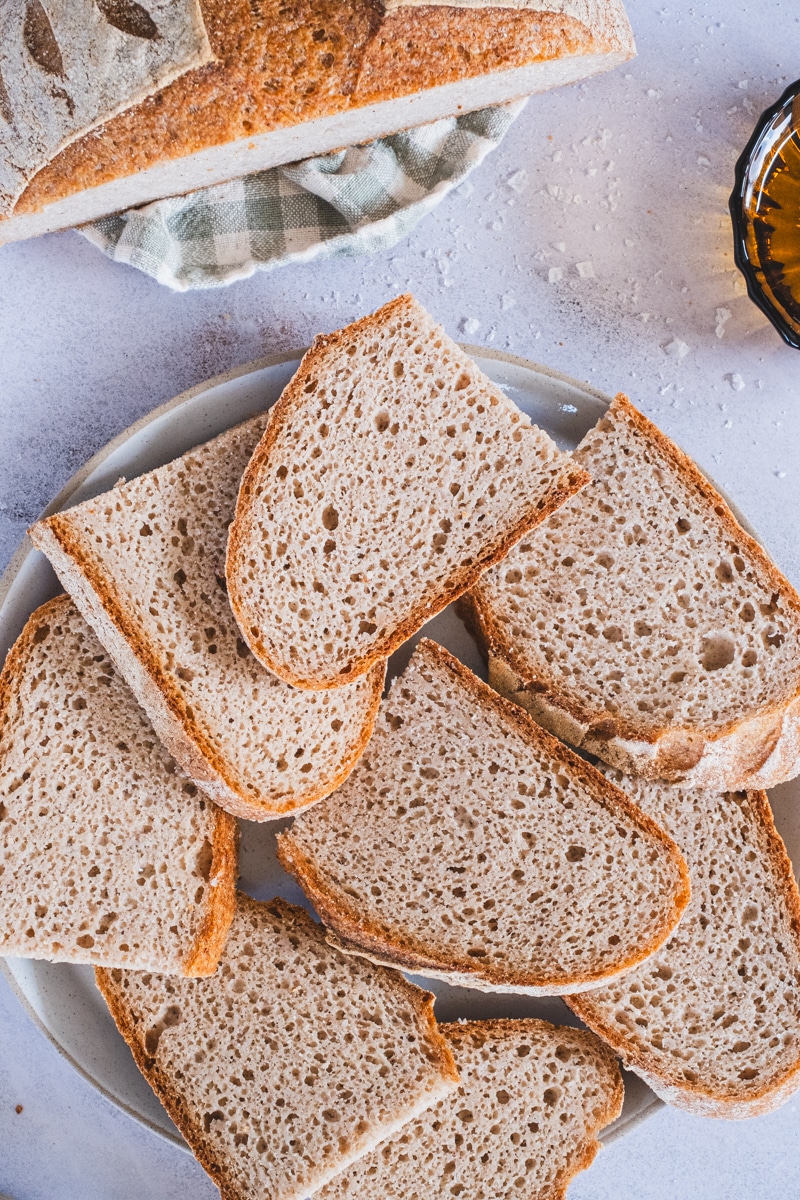

No Comments